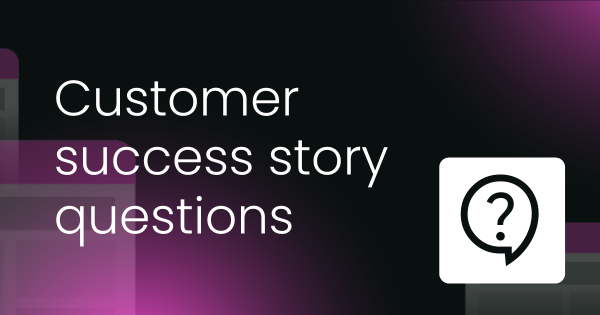The art of storytelling is an ancient practice that has evolved over thousands of years and is by no means slowing down. From the intergenerational legacy of its oral tradition, to physically turning a novel’s printed pages, even to binging your favorite new series on Netflix, it’s a craft that continually provokes intimacy between the storyteller and their recipient. 📖
But storytelling isn’t exclusively for the poets. Even in the modern world of business, storytelling can be utilized to generate a connection between brand and customer, cultivating meaningful and lasting relationships.
Much like the poets who don’t have a monopoly on storytelling, product storytelling isn’t purely a marketing technique – far from it. Customer success can harness the power of storytelling as a canny initiative to drive product adoption and to better understand its end-users.
Sam Basile's a Manager of Strategic Customer Success at ZoomInfo, and was one of the elite CS practitioners who spoke at March 2022’s Customer Success Festival. ZoomInfo is an AI-led business database that provides accurate and actionable B2B contact information to accelerate decision-making, as well as the growth of sales and marketing teams.
As chance would have it, Sam’s presentation is all about the role of storytelling in customer success. For Sam, product storytelling is “the ability to articulate a complex workflow, process, or platform in such a way that is relevant to your audience.” If you missed it, be sure to check it out OnDemand with one of our membership plans.
In this article, Sam gives us the down-low about product storytelling, specifically discussing:
- What is product storytelling?
- What is the most critical aspect of product storytelling?
- The main benefits of introducing product storytelling into your customer success strategy,
- The impact product storytelling has on customer retention,
- How to tailor your communication differently for your customers vs. your product team,
- What are your favorite discovery questions to ask?
- How to approach managing smaller teams,
- How best to collaborate with marketing and sales,
- How to adapt roleplay into your team's training,
- Examples of successful product storytelling in customer success,
- Where should you start if you plan on crafting a strategic product narrative?
- What are the biggest mistakes CS leaders make when tackling retention?
- How to data and technology in your bid to create a product narrative?
What is product storytelling?
Sam: A lot of people assume storytelling is immersing your audience with your product, making it personal, and creating an air of urgency. But within the customer success space, all customers want to hear how you are going to make their lives easier.
If you can tell a story in such a way that not only teaches someone how to use a tool or product but pinpoint when and where within their day they’ll use it. Not only will this make their life easier, but it can lead to greater adoption.
In short, you must find ‘the why’ behind your product and communicate this.

What is the most critical aspect of product storytelling?
Sam: The most critical part is reading the room and knowing your audience. If you deliver a story incorrectly it could ultimately lead to confusion and loss of trust. Knowing what triggers to avoid and how to navigate objections from end users is crucial. This again goes back to the importance of understanding ‘the why’ so you can use that as your north star.
What are the main benefits of introducing product storytelling into your customer success strategy?
Sam: When you’re trying to drive product adoption amongst your end-users, you’ve got to ask yourself what works better: a line-by-line overview of how to use the tool, or an in-depth story that highlights their business’ goals and metrics, explaining how using the product in a specific way will help them reach those goals?
Through deep discovery, the goal is to understand everything about your customer and end-users. Once you know that, you become an extension of that team. Wrapping it in a bow within a story allows everyone to view you as that product expert, which, in turn, will lead to greater retention of the information.

What kind of impact does product storytelling have on customer retention?
Sam: When it comes to customer retention, I have seen first-hand how storytelling can alter a relationship for the better.
When you utilize it appropriately you become an extension of their team, much like a trusted advisor. With this trust, you have the ability to make recommendations, highlight better workflows that could lead to greater adoption, and have insider knowledge that could lead to an upsell.
Customer retention increases not only because the product is working well, but also because your main point of contact starts to view you as an asset they can’t lose.
How to tailor your communication differently for your customers vs. your product team
Sam: This is all about the person to whom you're speaking. You need to understand what will motivate the product team, right?
Let’s imagine you’re speaking to an Account Manager; that Account Manager’s sole goal is to make a sale. So, when you're telling a story to them, position the message of this conversation around how they're going to close more deals. You’ve got to put yourself in the position of who you’re talking to.
The same principle applies to any conversation with any person. What do they want to hear?
When you're talking to someone in the product team, think about what they care about. They care about how many clicks a customer takes to use the product they’ve built, its ease of use, the flow of the design – all of these different things, right?
When you craft the story to product, remember to insert points that are relevant to the product team and how it's going to help their goals. Again, you’ve got to understand the person's goals that you're telling the story, too. That's how you can start to understand what you can add, or take away, from your story.
What are your favorite general discovery questions to ask?
Sam: I love being very open and honest.
If I'm talking to the Sales Team Manager, I’ll ask, “What is it that you wish your team would be doing today? What are the things that you're struggling to get your team to do? How can I help get you where we need to be?”
It’s all about making their life easier, asking questions like that helps you understand – whoever it is you're speaking to – their pain points and their goals. That's how you can start to steer the conversation in the right direction.
But again, it goes back to what I said earlier: really try to understand who you're speaking to, and ask questions that are relevant to that particular audience.
If you're managing smaller teams, do you recommend reaching out to the champion with a template to share, or taking the time to reach out to each user individually?
Sam: It depends on if there's a risk on the account. If there's an identifiable risk, I'll probably advise that people reach out on an individual basis to make things more personal. It’s also important to make sure we're maximizing our feedback here.
But if in general, you're just trying to understand more details about your customer and their workflow and other things like that, you can send a larger, more scaled campaign. We've had plenty of success doing that as well.

How do you collaborate with marketing and sales to create the best case studies to fuel your storytelling?
Sam: Your Customer Success Managers are at the frontline of these relationships. I know a lot of customer success teams split responsibilities differently; in one company, an Account Manager will be responsible for what a CSM may do in another. Generally speaking, the CSM really knows the relationship and knows the customer better than the Account Manager.
So what we do is we look for our customers that have the best success. Let's say we have a highly complex customer. They purchased all of our integrations and every tool, and we've implemented them smoothly; we've had a great relationship – there's a back-and-forth partnership with the main point of contact.
When we identify those accounts that are our bread and butter, we know them because we are that frontline. We’ll bring in our marketing team and say, “Hey, guys, I think I think we can we can build from this relationship, please come in here. I'm going to introduce you to this team”, and let that marketing team start to work their magic.

You've built trust in that advocate through storytelling and making their life easier. When you bring in other teams, they're going to respect those teams in the same way that they respect you. The most important factor is sourcing and cherry-picking the customers that you know are the best fit for a case study, and then really pulling in the right resources to complete that study at the end of the day.
Essentially, it all boils down to leveraging your relationship with the client.
Is it a part of your internal process to coach and roleplay with your own teams?
Sam: Although making an emotional connection is key to bringing customers along on the journey with you, this skill might not come naturally to every CS team.
This is not easy and it can take a lot of trial and error. But through trial and error comes knowledge. You’ll discover what works, what triggers to avoid, and what plays don't really work as well as you thought they would.
My advice for people where this doesn't come naturally is: try it, just give it a shot.
Try it on an end user that's part of a large deployment, that won't hurt the account and that's not going to put the account at risk. Explore trial and error. Experiment with A/B testing. Perform these role plays with your team to see what works. By the end of this, you’ll find yourself with a catalog of plays that work well that have proven successful.

How did you get into product storytelling?
Sam: In my time spent as a leader within the Four Seasons Resort, I realized very quickly that the information we had to speak with guests about wasn’t always positive. However, we didn’t want to make them upset so everything relied on positive storytelling.
We had to understand the context, where we fell short, and how we would resolve things. Then, we needed to articulate this in such a way that wouldn’t leave the guests feeling upset or as if they missed out on something. This was my first real exposure to the power of storytelling.
Fast-forward to today and you’ll find the role of storytelling part of my everyday. From getting executives to agree to join standard business reviews (SBRs) for my reps, to holding admins accountable to do additional training – it's all storytelling. If I didn’t make it relevant and applicable to their situation, they would never agree to meet.
Examples of successful product storytelling in customer success
Sam: I have tons of these to pick from, but this prime example shows customer escalation.
For instance, in one case I oversaw, a company renewed their subscription but somehow their renewal didn’t follow our normal processes. Now, as a result, this led to inaccurate banners being visible to end-users highlighting their seat on the plan would be deactivated. The main point of contact was, understandably, very upset as this created much confusion and a small loss in revenue as reps stopped using the tool to prospect.
My priority was to understand what had happened and how we would alter our internal processes internally to ensure it does not happen again.

I delivered my apology to the customer, explained our situation, why it happened, and what changes we have made internally to avoid it happening again in the future – our main point of contact was delighted by this. He saw what we were working with internally and my transparency was well received. He mentioned, “there was only one answer I was going to accept and you hit it perfectly.” I was transparent, and honest, owned up to our areas of opportunity, and moved on.
If I had not been able to tell this story in a way that was relevant, he would have continued being upset and likely kept escalating to senior leadership.
Where should you start if you plan on crafting a strategic product narrative?
Sam: The first step is simple: become a product expert. If you don’t have an air-tight understanding of the product it can hurt your credibility.
Once you know the product, then it's all about listening to your customers' pain points, goals, and objectives. Once you know all of that, you can weave it into your product overview to make it more relevant.
What would you say are the biggest mistakes CS leaders make when tackling retention?
Sam: When tracking retention, the majority of the focus is on the money. When you actually look at what goes into making a great CSM, most of the time it doesn’t involve the extra dollars. I think it’s our responsibility as leaders within the CS space to continue coming up with ways to track those non-monetary items that lead to expansion and greater retention.
How to use data and technology in a bid to create a product narrative
Sam: It's all customer-dependent. Take ZoomInfo, for instance. If the customer is tracking meetings booked, we can use their data on how many meetings are getting booked to see if there is an increase. If there is not, we know we need to go back to the drawing board on our story.
Decisions are made based on data, so understanding what data points are most important to your customer will help you understand how to use data and technology when storytelling to drive a point home.
Key takeaway
Sam: I hope people realize storytelling doesn’t have to be exclusively for people willing to speak in front of a room.
Anyone can be a good storyteller in their own way if they listen and make the content relevant. Remember to understand ‘the why’ from your customer and how your product is going to help them with that.

Get access to Sam’s killer presentation at this year’s Customer Success Festival APAC with one of our savvy membership plans and learn how you can weave meaningful stories into your CS strategy. 🎟



 Follow us on LinkedIn
Follow us on LinkedIn




